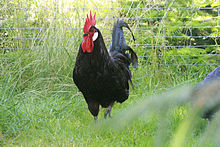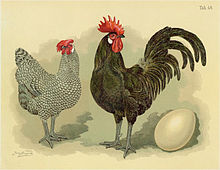The Bergische Schlotterkamm (German pronunciation: [ˌbɛʁɡɪʃə ˈʃlɔtɐˌkam]) is an old and endangered German breed of domestic chicken. It originates from the Bergisches Land, in the state of North Rhine-Westphalia in western Germany, and is one of three chicken breeds from that area, the others being the Bergische Kräher and the German creeper ("Krüper").
 Black cock | |
| Conservation status | |
|---|---|
| Other names | Elberfelder |
| Country of origin | Germany |
| Use | dual-purpose[2] |
| Traits | |
| Weight | |
| Egg colour | white |
| Comb type | single |
| Classification | |
| EE | yes[4] |
| |

History
editThe breed has been known since the eighteenth century and is probably the result of crossing imported Spanish birds with local Bergische Kräher stock.[5] At the beginning of the nineteenth century the breed experienced competition from imported multi-purpose breeds such as the Minorca, and became almost extinct. A breed association, the Vereinigung der Züchter Bergischer Hühnerrassen, was established in 1916.[6]
Today the Bergische Schlotterkamm is an endangered breed. In 2001 it was an "endangered breed of the year" of the Gesellschaft zur Erhaltung alter und gefährdeter Haustierrassen;[5] it is listed in category I, "extremely endangered", on the Rote Liste of that organisation.[7]: 162 In 2013 the total population was around 250.[5]
A bantam version of the Schlotterkamm was created in the late twentieth century by cross-breeding bantam Bergische Kräher and Thüringer Barthuhn birds. It is found in one plumage colour only, Silver-laced Black, and is even rarer than the full-sized Schlotterkamm.[4][8]
Characteristics
editThe Schlotterkamm is a medium-sized dual-purpose chicken. The shape is long and somewhat rectangular. It has a single comb which flops from one side to the other; it is this that gave the breed its name. Four plumage colours – Cuckoo, Silver-laced Black, Gold-laced Black and Black – have been recognised since 1896.[4][9] The old Cuckoo variant had virtually disappeared by 1922,[9] and the white Schlotterkamm disappeared as the Leghorn breed became more popular.[6]
Use
editThe Schlotterkamm is a dual-purpose breed, reared both for eggs and for meat. Hens lay about 150 eggs per year; the eggs are white and weigh about 55 g.[3] The hens have little tendency to broodiness.[citation needed]
References
edit- ^ Barbara Rischkowsky, D. Pilling (eds.) (2007). List of breeds documented in the Global Databank for Animal Genetic Resources, annex to The State of the World's Animal Genetic Resources for Food and Agriculture. Rome: Food and Agriculture Organization of the United Nations. ISBN 9789251057629. Accessed January 2017.
- ^ Breed data sheet: Bergische Schlotterkämme/Germany. Domestic Animal Diversity Information System of the Food and Agriculture Organization of the United Nations. Accessed January 2017.
- ^ a b c Rassetafeln: Bergische Kräher (in German). Bund Deutscher Rassegeflügelzüchter. Accessed August 2014.
- ^ a b c Liste des races et variétés homologuée dans les pays EE (28.04.2013). Entente Européenne d’Aviculture et de Cuniculture. Archived 16 June 2013.
- ^ a b c Bergische Schlotterkämme (in German). Gesellschaft zur Erhaltung alter und gefährdeter Haustierrassen. Accessed January 2017.
- ^ a b Bergische Schlotterkämme (in German). Vereinigung der Züchter Bergischer Hühnerrassen und deren Zwerge-Kräherzüchtervereinigung seit 1884. Archived 10 November 2016.
- ^ Rote Liste: Einheimische Nutztierrassen in Deutschland 2013 (in German). Bundesanstalt für Landwirtschaft und Ernährung. Archived 1 February 2014.
- ^ Bergische Zwerg-Schlottekämme (in German). Vereinigung der Züchter Bergischer Hühnerrassen und deren Zwerge-Kräherzüchtervereinigung seit 1884. Archived 10 November 2016.
- ^ a b Schwerpunkt - Geflügel: Bergische Schlotterkämme (in German). Gesellschaft zur Erhaltung alter und gefährdeter Haustierrassen. Accessed September 2015.
Media related to Bergischer Schlotterkamm at Wikimedia Commons